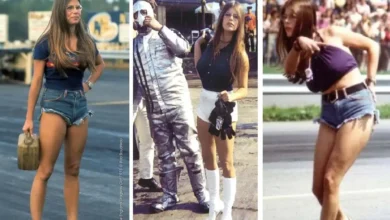
Drag racing, a unique and exhilarating motorsport has captivated enthusiasts around the world with its blend of speed, technical prowess, and vibrant culture. Originating from the streets of post-World War II America, this sport has grown into a global phenomenon, with a rich history and a deeply rooted culture that continues to evolve. This article delves into the history and culture of drag racing, tracing its origins, significant milestones, and cultural impact.
- What is Drag Racing?
- Origins of Drag Racing
- The Formalization of Drag Racing
- Top 5 Drag Racers
- Technological Advancements and the Rise of Professional Drag Racing
- Drag Racing in Popular Culture
- The Evolution of Drag Racing Culture
- Modern Drag Racing: Technology and Innovation
- The Future of Drag Racing
- Frequently Asked Questions (FAQs)
What is Drag Racing?
Drag racing is a type of motor racing where two vehicles compete to be the first to cross a finish line on a straight track, usually a quarter-mile or an eighth-mile long. The race starts from a standstill, with drivers reacting to a “Christmas Tree” light system that signals when to go. The objective is to cover the distance as quickly as possible, with performance measured by the elapsed time and reaction time. Vehicles, often highly modified for maximum speed and acceleration, include cars, motorcycles, and specialized dragsters. Safety is paramount, with numerous precautions in place due to the high speeds involved.
Origins of Drag Racing
The roots of drag racing can be traced back to the early 20th century, but it truly began to take shape in the 1930s and 1940s in the United States. During this period, young automotive enthusiasts, known as “hot rodders,” began modifying their cars for increased speed and performance. They would often race on deserted stretches of road or dry lake beds in California, particularly in areas like the Mojave Desert. These early races were informal, spontaneous events, characterized by a raw, rebellious spirit.
After World War II, the culture of hot rodding and informal street racing flourished. Returning servicemen, who had developed mechanical skills during the war, found solace and excitement in modifying cars and racing them. The war had also left behind numerous airstrips, providing perfect venues for these enthusiasts to test their vehicles. This era saw the emergence of a distinct hot rod culture, with young men and women embracing the thrill of speed and mechanical innovation.
The Formalization of Drag Racing
The post-war boom in hot rodding and street racing led to the need for a more organized and safer approach to the sport. In 1951, Wally Parks, a former editor of Hot Rod Magazine, founded the National Hot Rod Association (NHRA). The NHRA aimed to promote drag racing as a legitimate and safe motorsport, providing a structured framework for competitions. The association’s first official event, the NHRA Nationals, was held in 1955 in Great Bend, Kansas, marking a significant milestone in the formalization of drag racing.
The establishment of the NHRA brought about standardized rules, regulations, and safety measures, transforming drag racing from an underground activity into a recognized sport. This period also saw the construction of dedicated drag strips, with the first permanent drag strip, Santa Ana Drags, opening in 1950 in Orange County, California. These developments provided a controlled environment for racers to showcase their skills and pushed the boundaries of automotive performance.
Top 5 Drag Racers
Some of the top drag racers known for their exceptional skills, records, and contributions to the sport include:
- John Force: A legendary figure in NHRA drag racing, John Force is a 16-time Funny Car champion and one of the most successful and popular drivers in the sport’s history.
- Don Garlits: Known as “Big Daddy,” Don Garlits is a pioneer in drag racing, particularly in the Top Fuel category. He has won numerous championships and is credited with many innovations in drag racing technology.
- Shirley Muldowney: A trailblazer for women in drag racing, Shirley Muldowney is a three-time NHRA Top Fuel champion and the first woman to earn a license to drive a Top Fuel dragster.
- Tony Schumacher: With eight NHRA Top Fuel championships, Tony Schumacher is one of the most dominant drivers in the history of the sport.
- Kenny Bernstein: Nicknamed the “King of Speed,” Kenny Bernstein is known for being the first drag racer to break the 300 mph barrier in the quarter-mile. He has won multiple championships in both the Funny Car and Top Fuel categories.
Technological Advancements and the Rise of Professional Drag Racing
The 1960s and 1970s were a transformative era for drag racing, marked by significant technological advancements and the rise of professional teams. This period saw the introduction of specialized drag racing vehicles, designed solely for the purpose of achieving maximum speed over a short distance. The Top Fuel Dragster, powered by a supercharged nitromethane engine, emerged as the pinnacle of drag racing technology, capable of reaching speeds exceeding 300 miles per hour in a matter of seconds.
The era also witnessed the advent of Funny Cars, which were initially stock-bodied vehicles with extensive modifications. Funny Cars quickly evolved into purpose-built machines with lightweight, aerodynamic bodies and powerful engines. These cars became immensely popular due to their distinctive appearance and spectacular performances on the track.
The professionalization of drag racing also led to the establishment of other sanctioning bodies, such as the International Hot Rod Association (IHRA) in 1970. The NHRA and IHRA organized numerous national and regional events, providing a platform for drivers to compete at the highest level. Prominent racers like Don “Big Daddy” Garlits, Shirley Muldowney, and “TV Tommy” Ivo became household names, elevating the sport’s profile and inspiring a new generation of drag racers.
Drag Racing in Popular Culture
Drag racing’s influence extended beyond the track, permeating various aspects of popular culture. The 1950s and 1960s saw the rise of car culture in America, with hot rods and muscle cars becoming symbols of youth rebellion and freedom. This era produced iconic films such as “Rebel Without a Cause” (1955) and “American Graffiti” (1973), which captured the spirit of street racing and the allure of fast cars.
The sport’s popularity was further bolstered by the emergence of drag racing-themed songs, such as “Little Deuce Coupe” by The Beach Boys and “Dead Man’s Curve” by Jan and Dean. These songs celebrated the thrill of drag racing and helped cement its place in the American cultural landscape.
In the 21st century, drag racing continues to be featured in popular media, most notably in the “Fast & Furious” film franchise. The series, which began in 2001, has introduced a new generation to the excitement and drama of street racing and drag racing, contributing to the sport’s enduring appeal.
The Evolution of Drag Racing Culture
The culture of drag racing has evolved significantly over the decades, reflecting broader societal changes and technological advancements. The early days of hot rodding were characterized by a DIY ethos, with enthusiasts building and modifying their cars in garages and backyards. This spirit of innovation and experimentation remains a core aspect of drag racing culture, with modern racers continually pushing the limits of performance through advanced engineering and cutting-edge technology.
The sense of community within drag racing is another enduring cultural element. Local drag strips and events serve as gathering places for enthusiasts to share their passion, exchange knowledge, and compete in a friendly environment. The camaraderie among racers, regardless of their level of experience, is a testament to the sport’s inclusive and supportive nature.
Drag racing has also become more diverse over the years, with increased participation from women and minorities. Pioneers like Shirley Muldowney, the first woman to win an NHRA Top Fuel championship, paved the way for future generations of female racers. Today, women like Leah Pritchett and Barbara Roufs are making significant strides in the sport, challenging stereotypes and inspiring young girls to pursue their racing dreams.
Modern Drag Racing: Technology and Innovation
Modern drag racing is characterized by its reliance on advanced technology and engineering to achieve unprecedented levels of performance. The sport has embraced innovations in aerodynamics, materials science, and electronics, leading to the development of faster and more efficient vehicles.
One of the most significant advancements in recent years is the use of data analytics and telemetry. Teams now utilize sophisticated sensors and computer systems to monitor every aspect of their vehicles’ performance, from engine parameters to tire pressure. This data-driven approach allows for precise tuning and optimization, giving racers a competitive edge.
The introduction of electric drag racing vehicles is another notable development. Electric dragsters, like those competing in the National Electric Drag Racing Association (NEDRA) events, demonstrate the potential for electric propulsion to deliver blistering acceleration and speed. These vehicles represent a shift towards sustainability and innovation in the sport, aligning with broader trends in the automotive industry.
The Future of Drag Racing
As drag racing continues to evolve, it faces both challenges and opportunities. Environmental concerns and changing regulations are prompting the sport to explore alternative fuels and sustainable practices. The growing interest in electric and hybrid vehicles could lead to a new era of drag racing, where clean energy and high performance go hand in hand.
The sport’s ability to adapt to new technologies and societal trends will be crucial in maintaining its relevance and appeal. Virtual reality (VR) and augmented reality (AR) are emerging as tools to enhance the spectator experience, offering immersive and interactive ways to engage with the sport. These technologies could attract a younger, tech-savvy audience, ensuring the continued growth and vitality of drag racing.
Conclusion
Drag racing is more than just a motorsport; it is a vibrant subculture with a rich history and a dynamic future. From its humble beginnings on the streets and dry lake beds of post-war America to its status as a globally recognized and highly technical sport, drag racing has continually evolved while retaining its core essence of speed, innovation, and community.
The sport’s enduring appeal lies in its ability to captivate enthusiasts with the thrill of acceleration, the challenge of engineering excellence, and the camaraderie of a passionate community. As drag racing embraces new technologies and adapts to changing societal trends, it will continue to inspire and excite future generations of racers and fans alike. The legacy of drag racing is one of relentless pursuit of speed and performance, a testament to the human spirit’s unyielding drive to push the boundaries of what is possible.
We hope you found this article helpful. If you did, be sure to check out our blog for more great content like this.
Frequently Asked Questions (FAQs)
What is the difference between drag racing and drag driving?
Drag driving typically refers to the act of operating a vehicle in a straight line, potentially under high acceleration. Whereas, drag racing is a competitive sport where two vehicles race each other on a straight, short track, aiming to cross the finish line first.
Is drag racing a sport?
Yes, drag racing is considered a sport. It involves competitive racing between vehicles, adhering to specific rules, regulations, and safety standards.
What is a drag strip?
A drag strip is a specially designed straight track used for drag racing. It typically consists of a smooth, paved surface marked with lanes for racing. The strip is usually a quarter-mile (402 meters) or an eighth-mile (201 meters) in length and includes a start line, finish line, and timing equipment to measure race times accurately. Drag strips are equipped with safety features such as barriers, emergency equipment, and designated areas for spectators, making them suitable venues for organized drag racing events.
When did drag racing first start?
Drag racing traces its roots back to the early 20th century in the United States, particularly in the 1920s and 1930s. It originated from informal street races where drivers would challenge each other to straight-line races on public roads. These races were often held in rural areas or deserted stretches of highways. Over time, the popularity of drag racing grew, leading to the establishment of organized events and dedicated drag strips. The first official drag strip is often credited to the Santa Ana Drag Strip, which opened in California in 1950. From there, drag racing evolved into a highly organized and regulated motorsport, with numerous professional and amateur competitions held worldwide.





